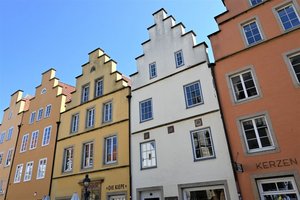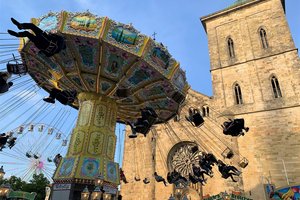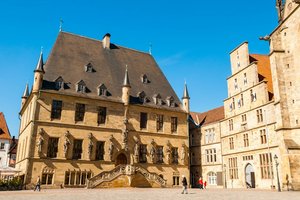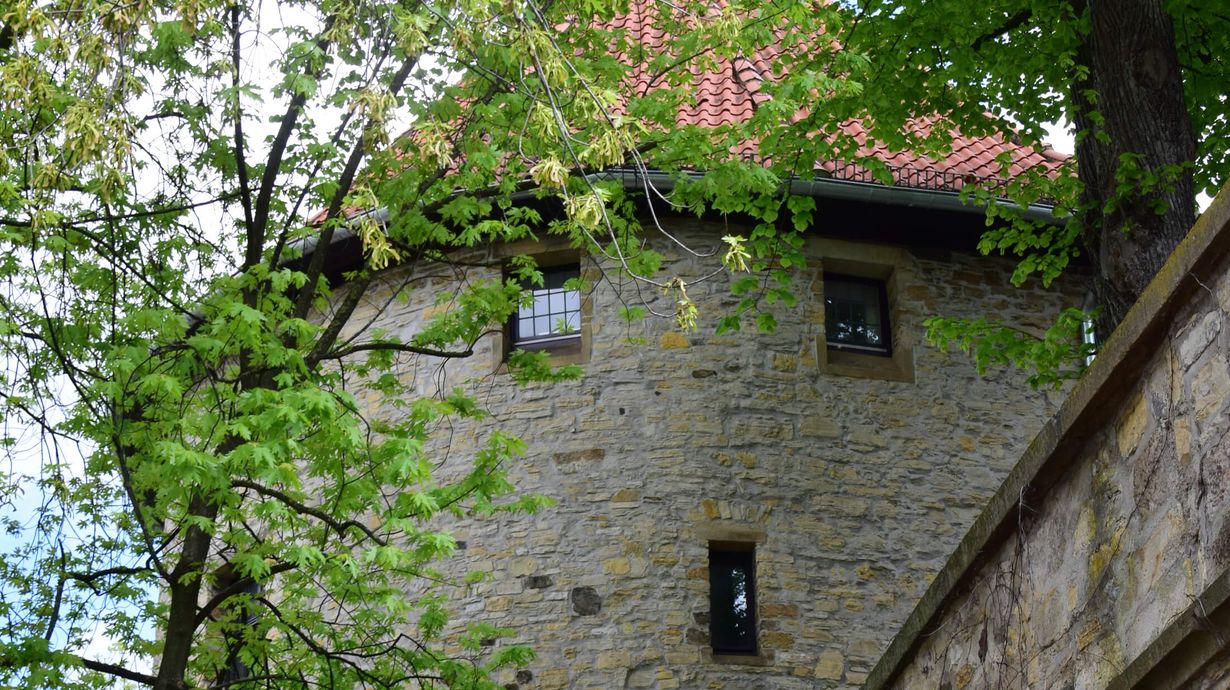The Bucksturm, which dates back to the 13th century, is located on the Bocksmauer in Osnabrück. Until most of the town's defences were demolished in the 19th century, the watchtower, formerly known as the Bocksturm, was part of the medieval town wall. A detailed plan from the time of the Thirty Years' War provides an overview of the ramparts and the original 30 fortifications that surrounded the town.
The Bucksturm was open from both sides and therefore accessible to the guards on duty via the city wall. In the winter months, they could warm themselves up in the tower with a brazier. The former entrances to the semi-circular tower are still recognisable today. With its original height of around 28 metres, it was considered the highest fortification tower in the city. However, ten metres had to be removed in 1805 due to dilapidation. Since then, it has had four storeys. The Bucksturm, which is still 18 metres high today, has a diameter of 10.7 metres and relatively small embrasures. This suggests that the tower was never intended for cannons, but only for small handguns.
On the west side of the Bucksturm is a war memorial by the sculptor Hermann Hosaeus for the infantry regiment "Herzog Friedrich Wilhelm von Braunschweig" No. 78, inaugurated on 1 October 1922.
Other remains of the former city fortifications include the Neustädter Turm, the Pernickelturm, the Plümersturm and the Vitschanze. What also remains is the Herrenteichswall, surrounded by lime trees on the River Hase, which invites you to take a stroll.
The interior of the Bucksturm cannot be visited.
Origin of name
Medieval Osnabrück had to defend itself with its own forces and had too few soldiers to do so. Partnerships were formed with noble families who undertook to defend part of the city wall in return for financial compensation. In the section of the later Bucksturm, the family responsible was called "von Buck" (for example, the "von Bar" family was responsible for another section). The noble families labelled their respective sections of the wall with their heraldic animals, the von Buck family with the buck and the von Bar family with the bear. A buck's head on the top floor of the tower, which no longer exists, is said to have signalled this. This allowed the soldiers to recognise which part of the city wall they had to defend.
The Johanniskasten
The Bucksturm tower gained historical significance during its time as a city prison. In 1305, Count Simon von der Lippe was imprisoned here for six years, as were the Anabaptist delegates from Münster in 1534. However, the Bucksturm is best known for the "Johanniskasten" on the second floor. From the 13th century onwards, prisoners were held in this box made of solid oak planks. The name comes from its most spectacular inmate: the robber baron Johann von Hoya, who was held in the box as a prisoner of war of the Osnabrückers from 1441 to 1448.
The Bucksturm and the witch hunt in Osnabrück
During the witch hunt, the Bucksturm also served as a torture chamber in the 16th and 17th centuries. A total of 260 deaths (256 women and four men) were recorded in Osnabrück between 1490 and 1639. Osnabrück became a centre of witch-hunts at the beginning of the modern era. Between 1583 and 1592, the wave of persecution escalated with 180 women executed. This strong persecution fervour was often intensified by personal interests and the active involvement of individual so-called "witch hunters", such as the Osnabrück mayors Rudolf Hammacher and Wilhelm Peltzer. The last major witch hunt between 1635 and 1639 can also be attributed to the latter.
Power politics and denominational conflicts had a strong influence on developments. The Protestant-dominated citizenry sought ways to secure and expand the city's autonomy and demonstrate its ability to act. Catholics were the main target of persecution as witches. The city council conducted the following trials as summary proceedings. The alleged witches were tortured in the Bucksturm before being burned or drowned (water test in the Hase), and some of them died during the process. It was not until the Swedish sovereign of Osnabrück at the time, Gustav Gustavson, cracked down on the persecution in 1639 that a decree put an end to it. Wilhelm Peltzer was removed from his office.
The case of Anna Ameldung
Anna Ameldung was the last victim of the Osnabrück witch hunts. She was the wife of the council pharmacist Heinrich Ameldung, owner of the "Löwenapotheke" pharmacy on the market square. The building, also known as the "Ameldung Pharmacy", is now home to the Erich Maria Remarque Peace Centre.
The Ameldungs were successful businessmen with a good reputation. A rumour that quickly spread about a family celebration was Anna's undoing: a cousin claimed that she had attended a witches' dance and had brought a tin of confectionery with her husband's initials on it. Heinrich Ameldung confronted the cousin and Anna defended him. This was interpreted as an admission of guilt. Heinrich Ameldung tried to protect his wife, but she was arrested on 1 August 1636 and the water test was carried out in the Hase on 20 September. The women were stripped naked, their arms and legs tied together and then thrown into a boat. An executioner then threw them into the Hase. The rope allowed him to determine who would sink or float to the top. Anna Ameldung was convicted of witchcraft (as she swam to the top as a witch). She was then tortured in the Bucksturm until she finally confessed to being a witch on 5 October. The council then sentenced her to death. In order to escape the shame of the stake, Heinrich Ameldung spent a lot of money to ensure that his wife was not burnt in front of everyone. On 7 October 1636 at four o'clock in the morning, she was beheaded in a guardhouse at the Bucksturm. The supposed tin of confectionery was never found.
At a glance
| Opening times |
The Bucksturm is currently closed. |






